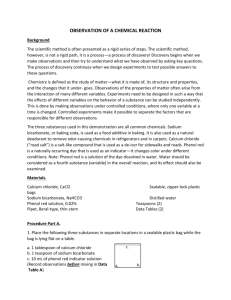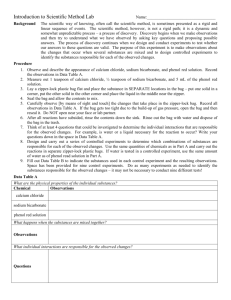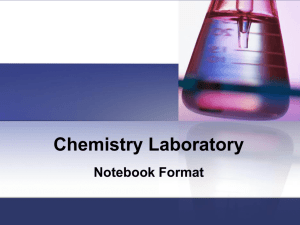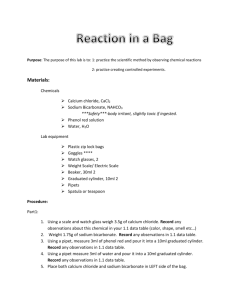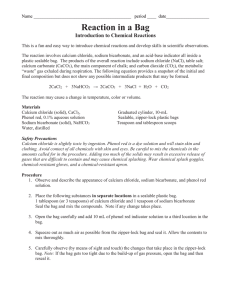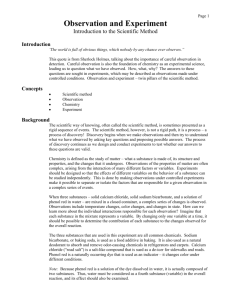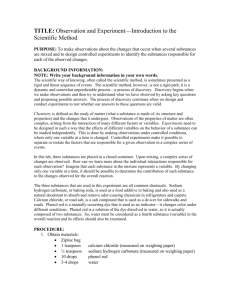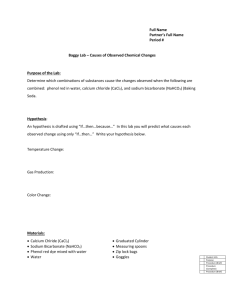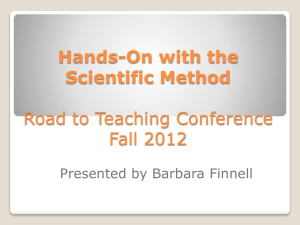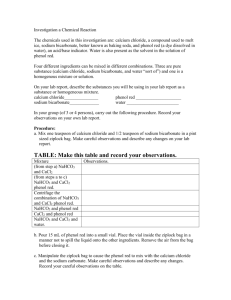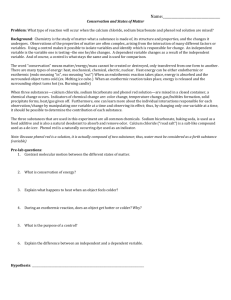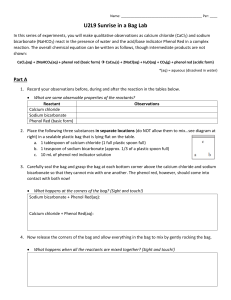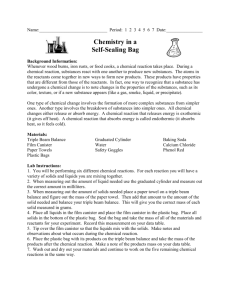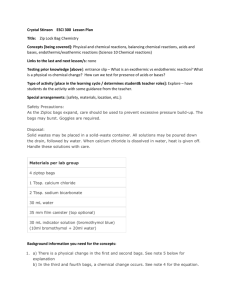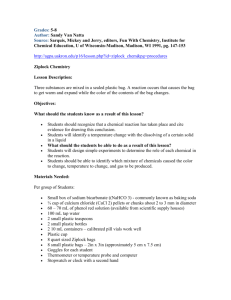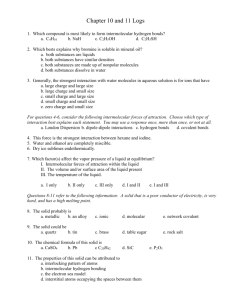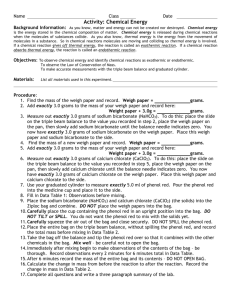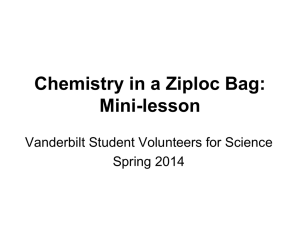1 Observation and Experiment
advertisement
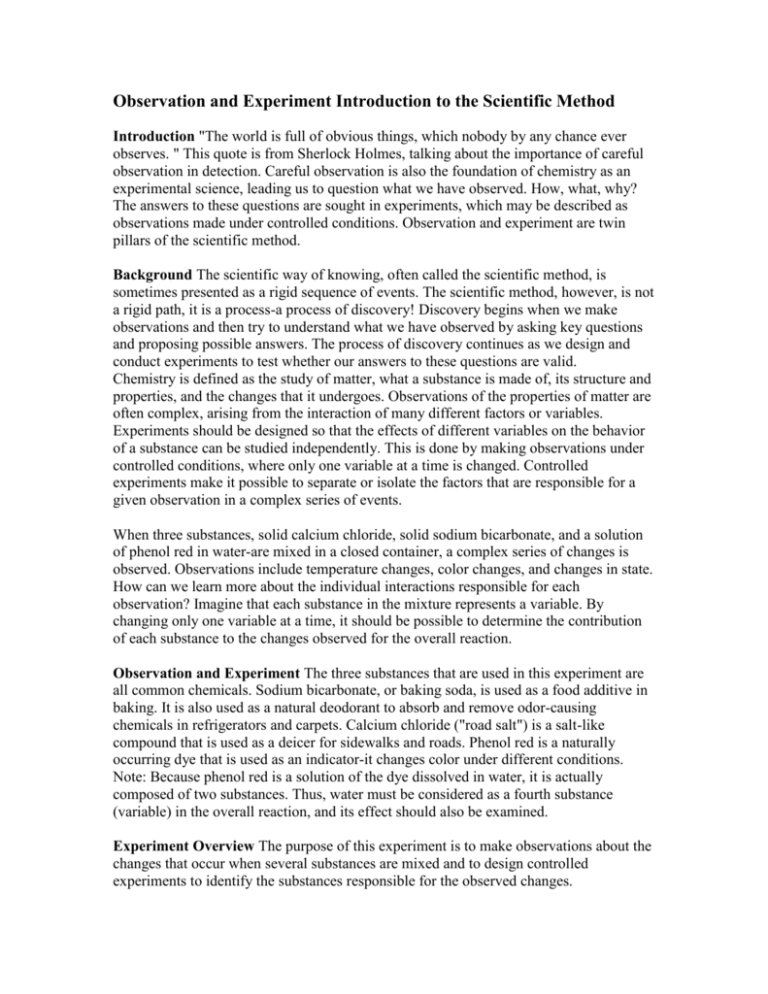
Observation and Experiment Introduction to the Scientific Method Introduction "The world is full of obvious things, which nobody by any chance ever observes. " This quote is from Sherlock Holmes, talking about the importance of careful observation in detection. Careful observation is also the foundation of chemistry as an experimental science, leading us to question what we have observed. How, what, why? The answers to these questions are sought in experiments, which may be described as observations made under controlled conditions. Observation and experiment are twin pillars of the scientific method. Background The scientific way of knowing, often called the scientific method, is sometimes presented as a rigid sequence of events. The scientific method, however, is not a rigid path, it is a process-a process of discovery! Discovery begins when we make observations and then try to understand what we have observed by asking key questions and proposing possible answers. The process of discovery continues as we design and conduct experiments to test whether our answers to these questions are valid. Chemistry is defined as the study of matter, what a substance is made of, its structure and properties, and the changes that it undergoes. Observations of the properties of matter are often complex, arising from the interaction of many different factors or variables. Experiments should be designed so that the effects of different variables on the behavior of a substance can be studied independently. This is done by making observations under controlled conditions, where only one variable at a time is changed. Controlled experiments make it possible to separate or isolate the factors that are responsible for a given observation in a complex series of events. When three substances, solid calcium chloride, solid sodium bicarbonate, and a solution of phenol red in water-are mixed in a closed container, a complex series of changes is observed. Observations include temperature changes, color changes, and changes in state. How can we learn more about the individual interactions responsible for each observation? Imagine that each substance in the mixture represents a variable. By changing only one variable at a time, it should be possible to determine the contribution of each substance to the changes observed for the overall reaction. Observation and Experiment The three substances that are used in this experiment are all common chemicals. Sodium bicarbonate, or baking soda, is used as a food additive in baking. It is also used as a natural deodorant to absorb and remove odor-causing chemicals in refrigerators and carpets. Calcium chloride ("road salt") is a salt-like compound that is used as a deicer for sidewalks and roads. Phenol red is a naturally occurring dye that is used as an indicator-it changes color under different conditions. Note: Because phenol red is a solution of the dye dissolved in water, it is actually composed of two substances. Thus, water must be considered as a fourth substance (variable) in the overall reaction, and its effect should also be examined. Experiment Overview The purpose of this experiment is to make observations about the changes that occur when several substances are mixed and to design controlled experiments to identify the substances responsible for the observed changes. Safety Precautions Calcium chloride is slightly toxic by ingestion. Phenol red is a dye solution and will stain skin and clothing. Avoid contact of all chemicals with skin and eyes. Be careful to mix the chemicals in the amounts called for in the procedure. Adding too much of the solids may cause chemical splattering or splashing. Wear chemical splash goggles, chemical-resistant gloves, and a chemical-resistant apron. Wash your hands with soap and water before leaving the laboratory. Procedure Part A. The Overall Reaction 1. Obtain jars of "calcium chloride" and "sodium bicarbonate," respectively. 2. Obtain measuring spoons to dispense the calcium chloride and sodium bicarbonate, respectively. Store the spoons in their respective containers and do not mix them up. 3. Observe and describe the appearance of calcium chloride, sodium bicarbonate, and phenol red solution. Record the observations in Data Table A. 4. Lay a zipper-lock plastic bag flat and place the following three substances in separate locations in the bag. a. One teaspoon of calcium chloride b. One-half teaspoon of sodium bicarbonate c. Five mL of phenol red indicator solution 5. Squeeze out as much air as possible from the zipper-lock bag and seal it. Allow the contents to mix thoroughly. 6. Carefully observe (by means of sight and touch) the changes that take place in the bag. Record all observations in your data table Note: If the bag gets too full or tight, open the bag and then reseal it. Do NOT open the bag near your face or the face of any of anyone else. 7. The contents of the bag may be rinsed down the drain under running water. Rinse out the bag with water and dispose of the bag in the trash. Part B Controlled Experiments Design and carry out a series of controlled experiments to determine which combinations of substances are responsible for the observed changes. Always use the same quantities of chemicals as in Part A. Carry out the reactions in small beakers. If water is tested in a controlled experiment, use the same amount of water as of phenol red solution in Part A. Do as many experiments as needed to identify the substances responsible for the observed changes. Post-Lab Questions (answer in complete sentences) 1. Based on the results of the controlled experiments, what combination of substances seems to be responsible for the observed temperature change in the overall reaction? 2. Was there a temperature change observed in any of the individual controlled experiments that was NOT observed in the overall reaction in Part A? Explain. 3. What color change was observed in the overall reaction? Do the controlled experiments provide any evidence concerning the combination of chemicals responsible for the observed color change? 4. Are temperature changes observed at the same time as the formation of gas bubbles? Explain. 5. What controlled experiments were done to evaluate if a liquid is necessary for the observed effects in Part A? Does any reaction occur in the absence of water? 6. What evidence suggests that a new chemical substance is produced in the overall reaction of the substances mixed in Part A? What combination of chemicals may be responsible for the new substance?

